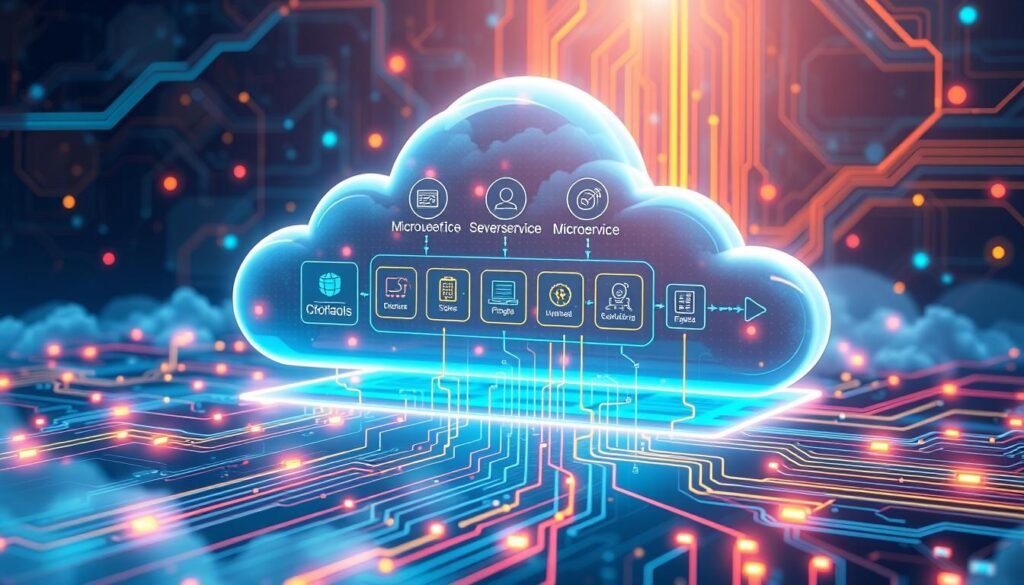By 2032, the cloud computing market is expected to grow a lot. It will reach over USD 2,321.1 billion, growing by 16% every year. This growth will change how businesses work and create new ideas.
The future of cloud computing is more than just storing and processing data. It’s a changing world that will make digital changes in many areas. Small companies and big ones are using cloud tech to keep up and be ahead.
Cloud computing will soon include artificial intelligence, quantum computing, and better security. These technologies are coming soon and will change our digital world a lot.
Key Takeaways
- Cloud computing market expected to reach $2.3 trillion by 2032
- 75% of organizations will adopt cloud-centered digital transformation by 2026
- Emerging technologies like AI and quantum computing will drive cloud innovation
- Multi-cloud strategies becoming standard for enterprise technology
- Security and compliance remain top priorities in cloud service development
The Evolution of Cloud Computing: A 2025 Perspective
Cloud computing is leading a big change in technology. It’s changing how businesses use digital tools. The cloud service world is growing fast, giving companies new chances to grow and adapt.
Current Market Growth and Projections
The cloud computing market is growing fast. By 2025, big changes are expected:
- Global cloud services expected to reach over $1 trillion market value
- Infrastructure as a Service (IaaS) projected to grow at 25-30% annually
- Platform as a Service (PaaS) anticipated to expand to $70 billion
Key Drivers of Cloud Technology Advancement
Several key factors are driving cloud growth and innovation:
- Increasing demand for on-demand services
- Rising need for flexible computing resources
- Cost-effective digital transformation strategies
“Cloud computing is not just a technology, it’s a fundamental business strategy for digital innovation.” – Cloud Industry Expert
Impact of Digital Transformation
By 2025, cloud adoption will change how businesses work. Gartner predicts 75% of businesses will leverage cloud infrastructure as their primary digital foundation. This change will help companies:
- Speed up innovation
- Improve how they work
- Save on keeping infrastructure running
| Cloud Service Type | Market Size 2025 | Annual Growth Rate |
|---|---|---|
| Software as a Service (SaaS) | $671 Billion | 15-20% |
| Platform as a Service (PaaS) | $70 Billion | 30%+ |
| Infrastructure as a Service (IaaS) | $1 Trillion | 25-30% |
AI-Powered Cloud Computing: Reshaping the Future
The world of cloud computing is changing fast, thanks to artificial intelligence. AI is making cloud automation and virtualization better. This opens up new chances for companies to improve their digital setup.
“AI is not just a technology, it’s the future of intelligent cloud computing” – Tech Innovation Report
The AI market is set to grow a lot, expected to grow more than 5 times by 2026. This growth will make cloud monitoring and computing better. It will help companies work more efficiently than ever before.
- AI-powered cloud automation cuts costs by up to 15%
- Intelligent virtualization lets resources be used in real-time
- Advanced cloud monitoring gives insights on performance
By 2025, almost 90% of companies will use AI in their cloud services. These tools offer better scaling, smart resource use, and security that changes with the company’s needs.
Key Benefits of AI-Powered Cloud Computing:
- 50% faster deployment of AI models
- 30% less IT infrastructure costs
- 65% better operational efficiency
As cloud tech gets better, AI will keep changing how businesses use digital tools. It will make cloud computing smarter, quicker, and cheaper.
Quantum Computing: Democratizing Advanced Computing Through Cloud Services
The world of computing is on the verge of a big change. Quantum computing will change how businesses solve tough problems. Big cloud providers like Amazon Web Services (AWS), Microsoft Azure, and Google Cloud Platform are leading this change.
Quantum cloud computing is a new way to tackle complex problems. By 2025, it will make advanced computing easy for all kinds of organizations. This will remove old barriers to using these powerful tools.
Cloud-Based Quantum Computing Platforms
Big companies are creating new quantum computing platforms. These platforms work well with current cloud systems. They offer huge computing power with several key features:
- Low-barrier access to quantum resources
- Scalable quantum computing capabilities
- Advanced problem-solving methodologies
- Reduced infrastructure investment requirements
Applications and Possible Breakthroughs
Quantum cloud computing has many uses that could change things a lot. Quantum technologies are expected to provide breakthrough solutions in critical fields like:
- Drug discovery and molecular simulation
- Financial modeling and risk analysis
- Complex system optimization
- Machine learning and artificial intelligence
“Quantum cloud computing will democratize advanced computational capabilities, making cutting-edge technology accessible to businesses worldwide.” – Tech Innovation Experts
Integration with Existing Infrastructure
Cloud providers are working hard to make quantum computing work with current cloud services. Microsoft Azure, AWS, and Google Cloud Platform are building strong platforms. These platforms make it easy to switch and work together.
By 2025, over 30% of cloud workloads will use quantum computing. This shows a big change in how we do computing.
Edge Computing and Cloud Integration: The New Frontier
The world of cloud computing is changing fast with edge computing. Your company can use a hybrid cloud approach. This brings computing closer to where data is stored. It makes computing faster and more responsive.
“Edge computing is revolutionizing how we process and manage data across distributed networks.” – Cloud Innovation Research Group
Edge computing brings big benefits to businesses today:
- Less delay for important apps
- Better data handling
- Stronger security for networks
- Smarter use of cloud storage
Using multiple clouds is key for companies wanting flexible solutions. By spreading workloads across different clouds, you can boost performance and cut down on service issues.
| Edge Computing Characteristics | Cloud Computing Benefits |
|---|---|
| Localized data processing | Scalable infrastructure |
| Lower latency | Centralized resource management |
| Reduced bandwidth consumption | Comprehensive cloud storage options |
As more edge computing devices appear, companies need strong plans to link them with their cloud setups. The future of computing is about making networks that work smoothly and adjust to needs.
By 2025, experts say edge computing will be key in business IT, leading to new ideas in many fields.
Understanding Service Models: SaaS, PaaS, IaaS
Cloud computing has changed how businesses use technology. The main service models – SaaS, PaaS, and IaaS – help businesses get flexible and scalable computing resources.
Exploring Cloud Service Models
Each cloud service model has its own benefits for businesses. Here are the main points:
- Software as a Service (SaaS): Offers ready-to-use applications over the internet
- Platform as a Service (PaaS): Gives development and deployment environments
- Infrastructure as a Service (IaaS): Provides virtualized computing resources
Benefits of Multi-Cloud Strategy
Using multiple cloud services can make your business more flexible and safe. You can:
- Save money
- Improve performance
- Get better disaster recovery
“Choosing the right cloud service model can transform your business’s technological capabilities.” – Cloud Computing Expert
Implementation Challenges and Solutions
Cloud services are great, but there are challenges to face.
| Service Model | Key Challenge | Recommended Solution |
|————–|————–|———————-|
| SaaS | Limited customization | Carefully evaluate vendor offerings |
| PaaS | Vendor lock-in risk | Develop exit strategies |
| IaaS | Complex security | Use strong monitoring tools |
By 2025, about 90% of businesses will use cloud services. Most will use more than one. IaaS will see the biggest spending growth, at 30.9%, followed by PaaS at 24.1%.
Knowing these service models helps you make smart choices. It ensures your technology meets your business needs and goals.
Serverless Computing: The Future of Application Development

Serverless computing is changing how we make apps by making infrastructure worries go away. It lets developers just write code. Cloud providers take care of the rest, making apps scalable and affordable.
“Serverless computing transforms how businesses build and deploy software, removing traditional infrastructure barriers.” – Cloud Innovation Research Group
The serverless computing market is growing fast. By 2025, it’s expected to hit $13.2 billion, growing 20.5% each year. More than 60% of companies are looking to use serverless computing.
Key Advantages of Serverless Computing
- Instant autoscaling capabilities
- Zero administrative burden
- 100% resource utilization
- Metered billing in 100-millisecond increments
- Enhanced multi-tenancy support
Serverless computing saves a lot of money. It can cut costs by up to 30% compared to old cloud services. About 55% of developers say they’re more productive because of it.
| Metric | Serverless | Traditional Models |
|---|---|---|
| Provisioning Time | Milliseconds | Minutes to Hours |
| Maintenance | 100% Provider Managed | Significant User Effort |
| Scalability | Instant, Zero to Max | Slower, Limited |
Serverless computing is leading the way in app development. It offers flexible, efficient, and affordable solutions. It’s key for businesses wanting to improve their digital setup.
Cloud Security and Compliance in 2025
Cloud technology is growing fast, making data security very important for companies all over the world. By 2025, how businesses protect their digital stuff and follow rules will change a lot.
The digital world is full of challenges for cloud security. With 80% of companies facing more cloud attacks, they need strong protection plans.
Advanced Threat Protection
Today’s cloud security is all about being proactive. Important steps include:
- Always watching the cloud environment
- Finding threats as they happen
- Using AI for security checks
- Quickly responding to security issues
Regulatory Compliance Frameworks
Following rules is tough, but cloud security can help. Companies need to meet big standards like:
- NIST 800-53
- HIPAA
- GDPR
Zero Trust Architecture
Zero Trust is the next big thing in cloud security. It doesn’t trust anyone, so it checks every time someone tries to get in.
| Security Metric | 2023 Status | 2025 Projection |
|---|---|---|
| Cloud Security Investments | $15.4 billion | $24.7 billion |
| Organizations with Cloud-First Strategy | 65% | 85% |
| Average Data Breach Cost | $4.45 million | $5.2 million |
“In the era of cloud computing, security is not an option—it’s a necessity.” – Cloud Security Alliance
Your cloud security plan should include good monitoring, strong threat protection, and flexible rules to keep your digital world safe.
Sustainable Cloud Computing: Green Technologies and Practices
The green cloud revolution is changing how businesses use cloud infrastructure. They now focus more on being environmentally responsible. Cloud computing is key in reducing carbon footprints and saving costs.
“Sustainability is no longer optional – it’s a strategic imperative for cloud technologies.”
Cloud providers are working hard on green technologies. For example, Google Cloud’s data centers use 50% less energy than others. They also match all their energy use with renewable energy. Amazon Web Services and Microsoft Azure have big plans to be carbon neutral:
- AWS aims for net-zero carbon emissions by 2040
- Microsoft Azure plans to be carbon negative by 2030
- Gartner predicts carbon emissions will be a top factor in cloud service purchasing by 2025
Virtualization is important for sustainable cloud computing. It helps use resources better and needs less physical hardware. This way, companies can reduce their environmental impact while keeping high performance.
Your organization can help by:
- Choosing cloud providers that care about the environment
- Using energy-efficient virtualization
- Reducing unnecessary computer use
The future of cloud computing is green, efficient, and aligned with global goals.
DevEdgeOps: Revolutionizing Cloud Development
The world of cloud computing is changing fast. DevEdgeOps is leading this change, making cloud management better. It mixes old ways of cloud work with new edge computing ideas. This gives companies more flexibility and better work.

DevEdgeOps is a big step forward in cloud work. It combines the quickness of DevOps with the special needs of edge computing. This lets your company move to the cloud easier and make complex systems work better.
Automated Deployment Strategies
Today’s cloud needs smart ways to set up. Important strategies include:
- Continuous integration and continuous deployment (CI/CD) pipelines
- Automated configuration management
- Scalable infrastructure-as-code implementations
Edge Computing Integration
Adding edge computing needs careful thought. Companies are finding ways to:
- Make data travel faster between cloud and edge
- Keep performance steady in far-off places
- Use strong security measures
“DevEdgeOps changes how we see cloud work, making hard systems easier to handle and quicker to respond.” – Cloud Innovation Expert
Performance Optimization Techniques
Improving performance in DevEdgeOps means using smart methods:
- Watching and analyzing things in real-time
- Changing resources on the fly
- Smartly spreading out workloads
By using DevEdgeOps, you can open up new chances in cloud computing. You can make systems stronger, more efficient, and more flexible.
Financial Operations (FinOps) in Cloud Computing
Cloud computing has changed how businesses use technology. FinOps is key for saving money on cloud costs. As more companies use cloud services, they need better financial management.
FinOps is about working together to manage cloud costs. It involves engineering, finance, and product teams. The main aim is to spend less money by using smart cloud monitoring and automation.
“FinOps enables organizations to balance speed, cost, and quality in cloud resource management.”
The FinOps process has three main stages:
- Crawl Stage: Basic policies start with little cost knowledge
- Walk Stage: Everyone in the company starts using it
- Run Stage: It’s fully used with advanced automation
Benefits of FinOps include:
- Up to 25% less spent on cloud costs each month
- Better financial control
- More teamwork between departments
- Optimizing cloud resources ahead of time
Using cloud automation and advanced monitoring tools helps businesses. They can make their cloud financial operations better. This way, every dollar spent is worth it.
Cloud Storage and Data Management Innovations
Cloud storage is changing how we handle digital data. By 2025, the global cloud storage market is set to hit $137 billion. This shows how vital advanced data management strategies are.
Your cloud storage strategy needs to keep up with new tech. Multi-tenancy architectures are getting better. They offer better data security and isolation for companies using shared cloud spaces.
“The future of cloud storage lies in intelligent, adaptive infrastructure that balances performance, security, and cost-effectiveness.” – Cloud Innovation Research Institute
Key Innovations in Cloud Storage
- Advanced hybrid cloud solutions enabling seamless data integration
- Enhanced multi-tenancy architectures with improved security protocols
- Intelligent data management techniques for efficient processing
- Scalable storage solutions with reduced operational costs
More companies are going for hybrid cloud strategies. This lets you mix public and private cloud storage. It boosts flexibility and data management skills.
| Storage Innovation | Key Benefits | Market Impact |
|---|---|---|
| Hybrid Cloud Storage | Improved scalability | 63% of organizations utilizing hybrid models |
| Multi-Tenancy Architecture | Enhanced data security | 92% expected multicloud adoption by 2025 |
| Intelligent Data Management | Faster processing | 30% reduction in data management costs |
By using these cloud storage innovations, you can change how you manage data. This ensures strong security, top performance, and flexibility in our digital world.
Conclusion
As we near 2025, the future of cloud computing is set to change everything. Almost all businesses, 94%, are already using cloud services. This makes your digital transformation plan essential, not just a choice.
The cloud migration journey is now a must for staying ahead. It brings flexibility and new ideas. Cloud technologies are changing fast.
By 2025, 83% of all business workloads will be in the cloud. This big change shows how cloud computing is reshaping how we work. More and more, businesses are choosing to use multiple clouds.
This multi-cloud strategy helps avoid being stuck with one provider. It offers scalable and cost-effective solutions. These meet the changing needs of the market.
Your business’s success will depend on using these new technologies. The cloud computing market is expected to hit $832.1 billion. This growth is not just about tech—it’s about staying ahead in business.
Whether you’re new or established, knowing how to use cloud strategies is vital. It’s not just about storing data anymore. It’s about building smart systems that drive growth and efficiency.
Your path to success begins with a smart approach to cloud technology. It’s time to think ahead and embrace the future of cloud computing.



